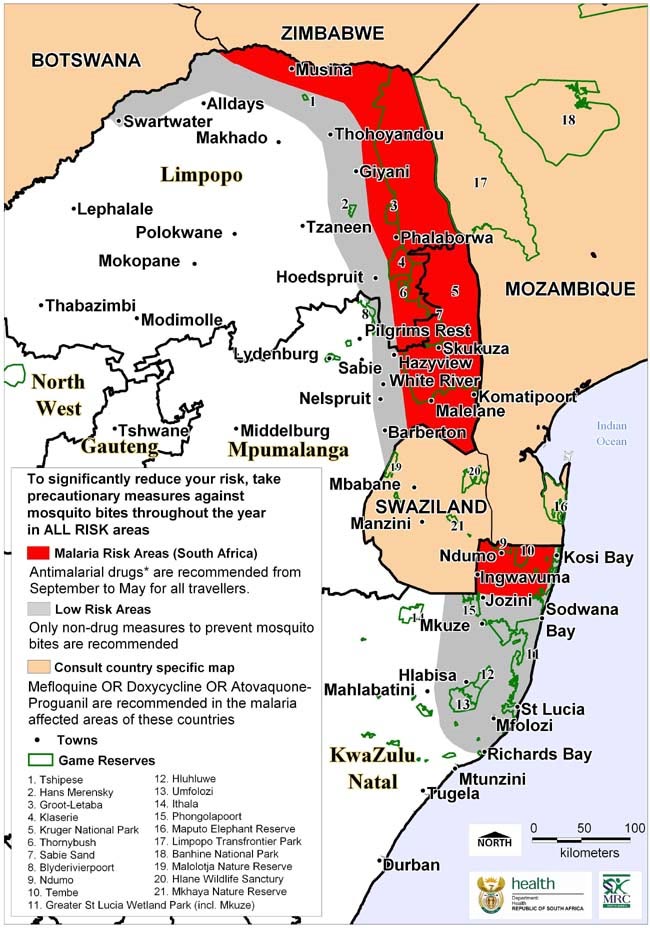Malaria in South Africa - The Silent Killer
What is Malaria?
Malaria is a disease caused mainly by the parasite Plasmodium falciparum. The parasite is transmitted to humans by certain malaria carrying female anopheles mosquitoes.
Plasmodium is a group of one-celled animal parasites that lives in the red blood cells of many birds, reptiles and mammals. There are four human malaria species. P. falciparum, P.ovale, P.vivax, and P.malariae, with P.falciparum being the most dangerous and most common.
Malaria Risk Areas in South Africa
Malaria is mainly transmitted in the low altitude ares of the northeastern parts of South Africa, including the lowveld region of Mpumalanga, Northern Province, and the northeastern parts of KwaZulu-Natal. Malaria transmission in South Africa happens seasonally, with the greatest risk during October and May.
Malaria Risk in countries neighboring South Africa
Malaria Distribution in South Africa
Click image to view the full map
Precautions against Malaria in South Africa
Visitors to high risk Malaria areas in South Africa should take precautions between dawn and dusk. Some of the precautions include:
- Apply insect repellent to exposed skin
- Remain indoors if possible
- Close all unscreened windows and doors at night
- Burn mosquito coils in sleeping areas, and spray aerosol insecticide
- Sleep under a mosquito-proof bed-net
- Use anti-malaria drugs in high risk areas
Malaria Prophylactics
It is sometimes recommended to use Malaria Prophylactics when visiting certain Malaria areas in South Africa. Malaria Prophylactics are generally started 1 - 2 weeks before entering the Malaria area. The dosage should be continued for four weeks after leaving the Malaria area.
Malaria Symptoms
Malaria symptoms are very similar to flu symptoms, and if you start experienced these symptoms from 10-14 days after your visit, up to about six months of your visit to the Malaria area, it is very important to consult your physician for a check-up.
Symptoms can include:
- Fatigue
- Headache
- Fever
- Muscular and joint pains
- Sweating
- Shivering
- Nausea
- Diarrhea
Treatment of Malaria
Oral treatment is usually enough to clear up a case of uncomplicated Malaria. For more severe cases of Malaria, intravenous and intra muscular treatment is required. Symptomatic treatment is given for fever and other symptoms.
Facts about Malaria in South Africa
- The female anopheles mosquito is not known as the "silent killer" for
no reason. She does not buzz around your head at night irritating you, and you may
not even be aware of her presence. Accordingly, you may not even be aware of the
bite, as it is not as pronounced as is common with other bloodsucking insects.
- Mosquitoes. can build up resistance to various forms of anti-malaria drugs, it is therefore very important that you seek the latest advice from your travel clinic.
- Mosquitoes. will bite anyone, so, just because you may be South African, it does not mean that you are immune. Consult your physician whenever you plan on visiting a Malaria area.
- With the exception of Cerebral Malaria, Malaria does not usually kill if treatment is sought timeously.
- Malaria occurs in 90 countries at present
- The P. falciparum infection overrides Malaria contracted simultaneously from other species. That is why other strains of Malaria can flare up once P. falciparum is cleared up.


 Map of South African Attractions
Map of South African Attractions  South African Attractions with GeoCaches
South African Attractions with GeoCaches